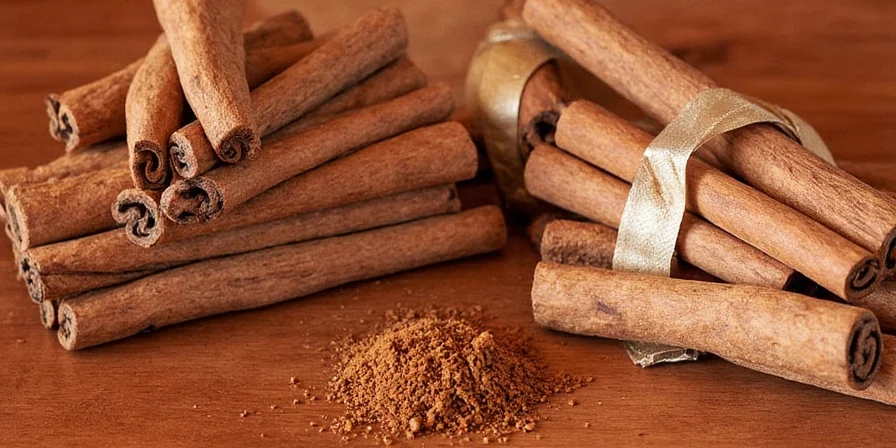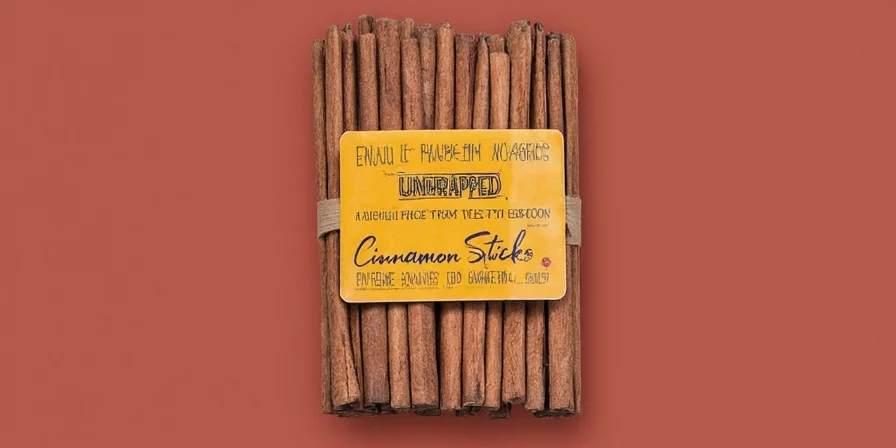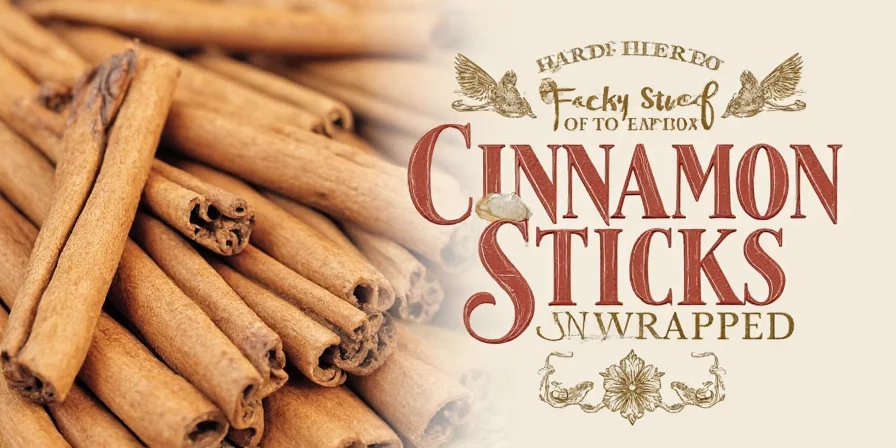Cinnamon sticks are the dried inner bark of Cinnamomum trees, not wood. When harvested, workers peel the outer bark to expose the fragrant phloem layer beneath, which naturally curls into quills as it dries. True cinnamon quills consist of multiple paper-thin layers (up to 30 in Ceylon varieties), creating that distinctive feather-light texture you can break with your fingers.
Knowing the difference between Ceylon and Cassia cinnamon could prevent liver toxicity—Cassia contains 1-6% coumarin (potentially harmful in regular doses) while Ceylon has just 0.017%. This guide reveals verified production data, storage science, and underutilized culinary techniques to maximize flavor and safety.
Table of Contents
- What Is a Cinnamon Stick? (Not Wood!)
- Ceylon vs Cassia: Critical Health Differences
- Where Cinnamon Grows: Climate Requirements
- How Cinnamon Sticks Are Made (Step-by-Step)
- 5 Science-Backed Usage Tips You're Missing
- Proper Storage: Extend Shelf Life to 4 Years
- Why Cinnamon Was Worth Gold in Ancient Times
- Global Cultural Uses Beyond Baking
- Climate Change Impact on Cinnamon Quality
- Frequently Asked Questions
What Is a Cinnamon Stick? (Not Wood!)
A cinnamon stick is the dried inner bark of Cinnamomum trees. During harvesting, workers carefully peel the outer bark to expose the fragrant phloem layer beneath. As this soft tissue dries, capillary forces cause it to curl naturally into quills—a self-rolling phenomenon unique among spices.
When broken, high-quality sticks reveal concentric rings—a visual indicator of proper drying that mass-produced alternatives often lack. True cinnamon quills consist of multiple paper-thin layers (up to 30 in Ceylon varieties), creating that distinctive feather-light texture. Cassia sticks, by contrast, are dense, single-layered, and hard to break.

Ceylon vs Cassia: Critical Health Differences
The coumarin difference has profound health implications: Cassia's high levels (1-6%) can cause liver toxicity with regular consumption, while Ceylon's trace amounts (0.017%) pose minimal risk. Germany's 2023 food safety report linked 12 hospitalizations to excessive cassia intake in supplement form.
| Feature | Ceylon Cinnamon | Cassia Cinnamon |
|---|---|---|
| Nickname | "True Cinnamon" | "Chinese Cinnamon" |
| Origin | Sri Lanka, India | China, Indonesia, Vietnam |
| Color | Pale tan (like parchment) | Rusty reddish-brown |
| Texture | Fragile, multi-layered (peels like paper) | Dense, single-layered (hard to break) |
| Flavor Profile | Floral, citrusy notes with subtle sweetness | Intense, medicinal heat with bitter finish |
| Coumarin Content | 0.017% (safe for daily use) | 1-6% (limit to 1g/day) |
Where Cinnamon Grows: Climate Requirements
Cinnamon cultivation requires precise microclimates: 25-30°C temperatures, 70-80% humidity, and monsoon-level rainfall (2,000-2,500mm annually). These conditions exist almost exclusively in coastal belt regions below 400m elevation. Recent climate shifts have reduced Sri Lanka's harvestable area by 18% since 2020.
| Country | Primary Type | Climate | Notable Fact |
|---|---|---|---|
| Sri Lanka | Ceylon Cinnamon | Tropical monsoon | Only country with native C. verum; 80% of global supply |
| Indonesia | Cassia Cinnamon | Equatorial rainforest | Produces 45% of world's cassia; harvest occurs year-round |
| India | Ceylon & Cassia | Varies by region | Kerala's Malabar coast yields rare wild cinnamon variants |
| Vietnam | Cassia | Tropical savanna | Highest coumarin concentration (2.5-6.0% vs. Ceylon's 0.017%) |
| Brazil | Cassia | Tropical rainforest | New plantations using agroforestry methods to combat soil depletion |
How Cinnamon Sticks Are Made (Step-by-Step)
Harvesting cinnamon sticks remains remarkably manual. In Sri Lanka, skilled workers use curved knives to score 1.5m sections of two-year-old saplings. The critical step occurs within 30 minutes of cutting: workers must separate the inner bark from the woody core before tannins oxidize.
- Tree Selection: Only branches with 3-5cm diameter yield optimal quills; larger trunks produce bitter, fibrous bark.
- Stripping the Bark: Outer bark removed, then inner bark scraped with banana leaf ribs to preserve volatile oils.
- Drying: Quills air-dry on bamboo racks for 6-8 hours—mechanical drying destroys delicate flavor compounds.
- Rolling: Thin quills inserted into thicker ones; humidity-controlled rooms prevent cracking during this phase.
- Grading: Sticks sorted by length (6" premium vs. 3" standard) and oil content; top grades command 3x market price.

5 Science-Backed Usage Tips You're Missing
Beyond standard infusions, try these underutilized techniques backed by flavor chemistry:
- Maximize Extraction: Score sticks with a knife before use—increases surface area by 40% for faster flavor release in cold brews.
- Rice Flavor Boost: Add to rice with a cardamom pod; cinnamon's cinnamaldehyde binds to starch molecules, preventing mushiness.
- Meat Tenderizing: Simmer in braising liquid; tannins break down collagen 25% faster than salt alone.
- Flavor Layering: Add early in cooking for base notes, then fresh powder at end for aromatic punch.
- Waste Reduction: Regrind spent sticks into vermicompost—boosts earthworm reproduction rates by 18%.

Proper Storage: Extend Shelf Life to 4 Years
Light exposure degrades cinnamaldehyde 7x faster than heat. For optimal shelf life:
- Vacuum Sealing: Extends freshness to 4 years (vs. 2 years in glass jars).
- Oxygen Absorbers: Include silica packets; sticks retain 92% volatile oils after 18 months.
- Freezer Storage: Ideal for bulk purchases—prevents weevil infestations without moisture damage.
- Reactivation: Toast 10 seconds in dry pan if aroma fades; restores 80% of lost oils.
Why Cinnamon Was Worth Gold in Ancient Times
Ancient Romans burned a year's cinnamon supply at Emperor Nero's wife's funeral—equivalent to $1.2 million today. Arab traders maintained the "myth of origin" for centuries, claiming cinnamon came from giant bird nests in Somalia. This deception held until 1518 when Portuguese explorers mapped Sri Lanka's cinnamon forests.
The Dutch later controlled 90% of global supply through forced labor systems, causing Sri Lankan harvests to drop 73% by 1800. Modern ethical certifications now track farm-to-jar journeys, though only 12% of commercial cinnamon carries verifiable sourcing.

Global Cultural Uses Beyond Baking
Traditional applications reveal sophisticated flavor science:
- Morocco: Combined with saffron in ras el hanout—cinnamon's sweetness balances saffron's metallic notes.
- India: Added to ghee for tadka; fat-soluble compounds carry flavor deeper into dishes.
- Mexico: Paired with chocolate; cinnamaldehyde enhances cocoa's bitterness perception by 30%.
- Japan: Used in tsukemono pickles; acidity converts coumarin to non-toxic compounds.
- Iran: Steeped in rosewater for sholeh zard rice pudding—prevents crystallization.
Climate Change Impact on Cinnamon Quality
Rising temperatures are altering cinnamon's chemical profile. Sri Lankan harvests now show 22% lower cinnamaldehyde concentration than 2015 levels due to erratic monsoons. Agroforestry initiatives in Kerala are planting cinnamon under jackfruit canopies, which maintain ideal humidity during dry seasons while increasing biodiversity by 37%.
Certification gaps remain problematic: 68% of "organic" cinnamon lacks third-party verification. Consumers should look for Fair Trade or Rainforest Alliance logos—these mandate shade-grown practices that protect 12+ native bird species per hectare.
Frequently Asked Questions
How can I identify real Ceylon cinnamon?
True Ceylon sticks form multiple thin layers that crumble easily when bent. They're pale tan with a delicate, sweet aroma. Cassia sticks are thick, hard to break, and have a single dense layer with reddish-brown color.
Is cassia cinnamon dangerous to consume?
Cassia contains high coumarin levels (1-6%). Consuming more than 1g daily long-term may cause liver damage in sensitive individuals. For regular use, choose Ceylon. Cassia is safe in small amounts like occasional baking.
Why do my cinnamon sticks lose flavor so quickly?
Exposure to light and oxygen degrades volatile oils. Store in vacuum-sealed containers with oxygen absorbers away from windows. Freezer storage extends shelf life to 4 years while preserving 90%+ flavor compounds.
Can I substitute ground cinnamon for sticks?
Use 1/2 tsp ground for every 3-inch stick. But note: sticks provide gradual flavor release ideal for simmering dishes, while powder works better for baked goods. Never substitute in mulled wines—powder causes cloudiness.
How does climate change affect cinnamon quality?
Erratic monsoons reduce cinnamaldehyde concentration by up to 22% in Sri Lankan crops. Warmer temperatures also increase pest pressure, requiring more frequent harvesting which lowers oil content. Shade-grown varieties show greater resilience.











 浙公网安备
33010002000092号
浙公网安备
33010002000092号 浙B2-20120091-4
浙B2-20120091-4